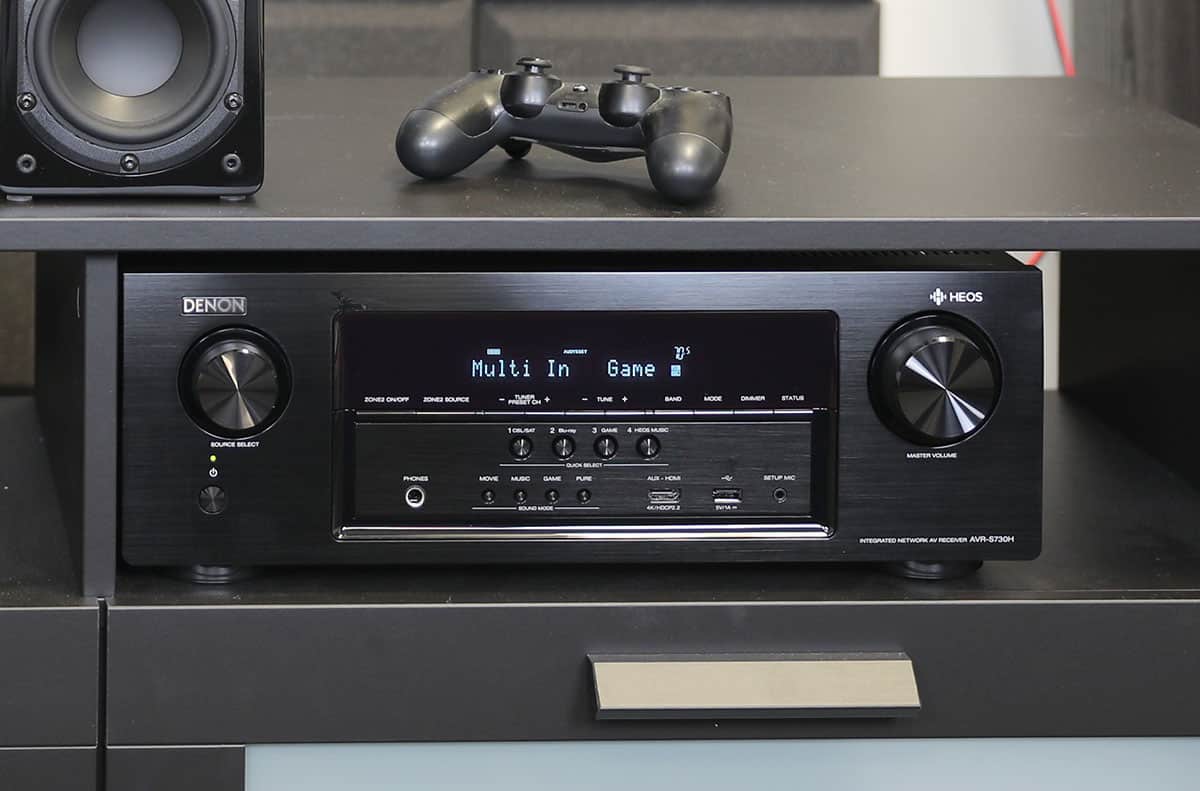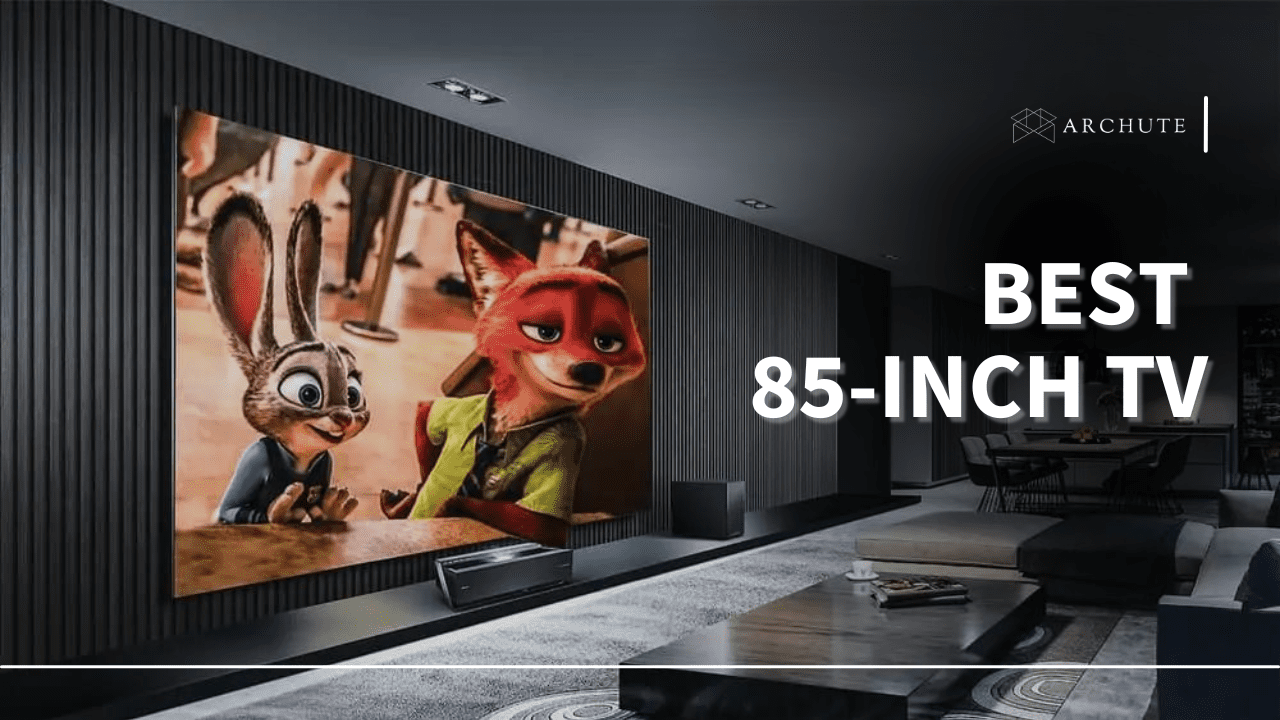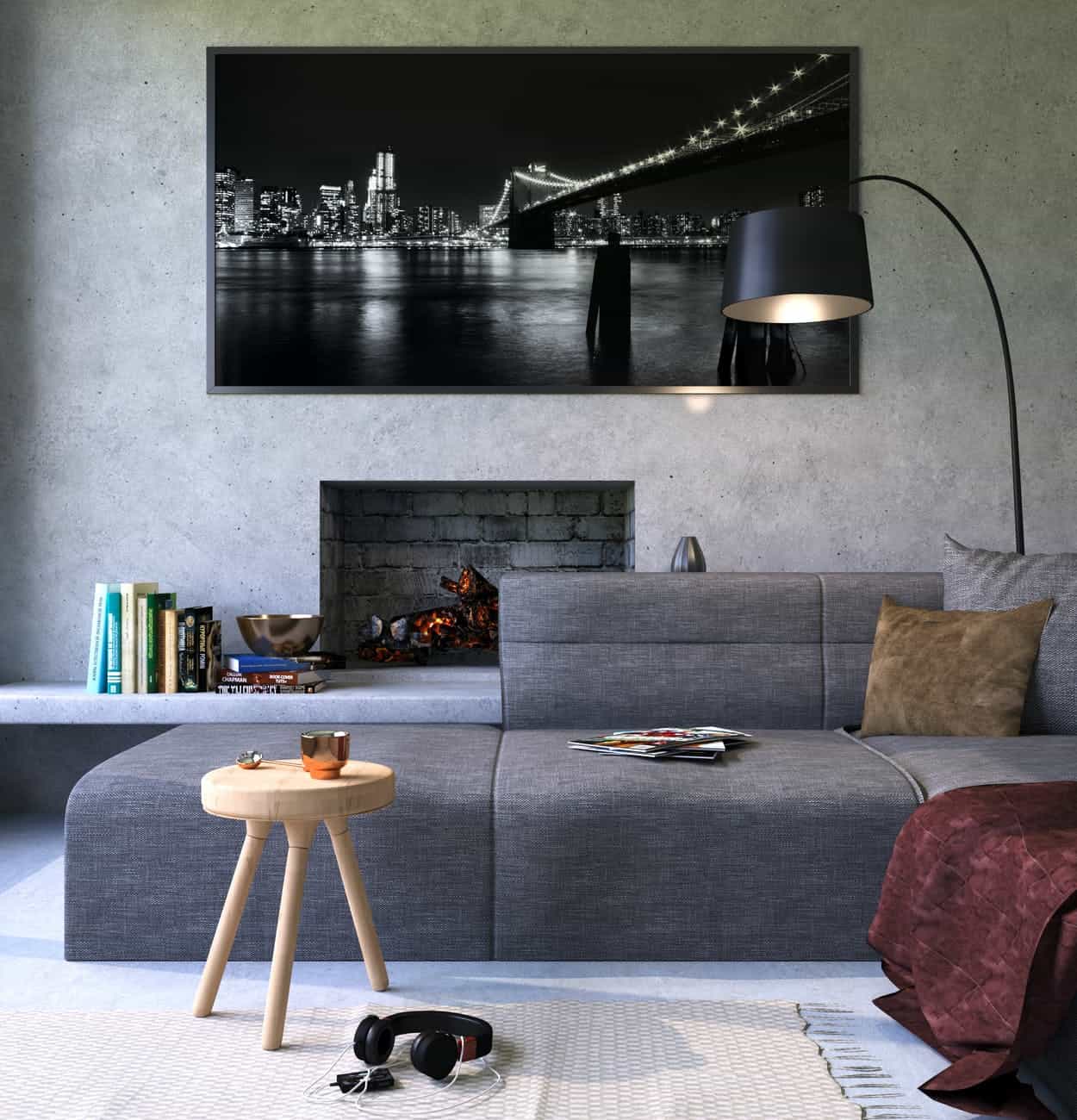If you want to re-create a genuine movie-theater experience at your home, there is no substitute for a good AV receiver. The best AV receiver will ensure your TV and films sound powerful, complete, and dynamic and offer you that immersive experience. Take it to be the traffic cop of your audio-video system, where it routes video from the sources to your display, then sending audio to your surround speakers.
What’s An AV Receiver?
An audio/video (AV) receiver is a consumer electronics component that acts as the "brain" in a home theater system. It's the central hub of your whole setup. Its role is to receive audio and video signals from several sources, process them, and offer power amplifies to form loudspeakers and route the video to displays sort of a TV, video projector, or monitor.
Moreover, inputs may come from a radio, video game consoles, DVD players, satellite receivers, Blu-ray Disc players, or VCRs, among others. A remote controller usually sets the AV source option and settings like volume. So what's the importance of having an AV receiver?
First, it's a multichannel amplifier that usually powers your surround sound speaker system so you can enjoy cool music. Second, it usually sends the picture to your projector or TV. Third, it makes it very easy to connect and choose different playback devices. Games consoles, CD players, Blu-ray players, video cameras, or content from your Smartphone. Last but not least, connecting all these devices into one unit makes it much easier to operate several audio-visual sources and set up.
1. Denon AVR-S540BT 4K Ultra HD AV Receiver, 5.2 channel
- MAKE THE MOST OF YOUR 4K UHD TV – At 140W per channel, the...
- YOUR FAVORITE MUSIC AT YOUR FINGERTIPS - With built-in Bluetooth,...
- OUR EASY ON-SCREEN SETUP ASSISTANT walks you through clear simple...
- FOUR QUICK SELECT BUTTONS ON THE FRONT PANEL help you store your...
- With its 100-year legacy and Japanese precision technology, Denon...
If you have a 5.1-channel system and want to upgrade to an AV receiver that supports 4K and HDR video or want to set up a basic 5.1-channel surround-sound system, count on the Denon AVR-S540BT 4K Ultra Receiver. This AV receiver is very easy to install and use, and it performs perfectly. It usually comes with 5 HDMI inputs; however, it can only stream music over Bluetooth. Moreover, the built-in Bluetooth allows you to play music from eight multiple gadgets and generate an integrated multi-room audio system with the Denon HEOS LINK.
The Denon AVR-S540BT 4K Ultra Receiver allows wireless music streaming from Pandora, Spotify, TIDAL, and more. Also, the receiver comes with 4 quick option buttons on the front panel, which help you store your favorite audio settings for TV, Blu-Ray, and more, plus it allows you to switch quickly between them.
Furthermore, you can connect the AV receiver with your Smart TV Remote and access the speaker sources and surround mode options using one remote. Or opt to download the Denon 500 Series Remote App for Android and iOS and control the AV through your Smartphone.
Pros:
Cons:
2. Denon AVR-X3700H 2020 8K Ultra HD Channel AV Receiver
- UNMATCHED 3D REALISM FOR YOUR HOME THEATER SYSTEM – Enjoy...
- Enjoy high quality 3D audio and video knowing that AVR-X3700H IS...
- NEXT GEN GAMING – Enjoy a smooth, lag-free gaming experience...
- ENJOY THE MOST ADVANCED VIDEO TECHNOLOGY AVAILABLE with Dynamic...
- CONNECT WITH ANY HD/ULTRA HD TV, SUBWOOFER, BLU-RAY PLAYER AND...
If you're looking for one of the best AV receivers that support 4K video at 120H and 8K at 60Hz, we recommend the Denon AVR-X3700H 9.2 Channel AV receiver. The AV receiver has the connections it requires to support key features so that you can build a television gaming setup around it. Furthermore, it can support VRR. HDR will continue to operate for video sent via the Denon ACR-X3700H, including HDR10+ content and Dolby Vision.
The AV receiver comes with 7 HDMI inputs; you can get many video sources easily connected to your television. Also, you can get a ton of speakers connected since the AV receiver supports 9.2-channel surround sound along with DTS Virtual:X and Dolby Atmos. Besides, unlike the most high-end AV receivers that support over-the-top setups, the Denon AVR-X3700H 9.2 Channel AV receiver fits well in the middle of the pack. Plus, it's compatible with Amazon Alexa, Google Assistant, and HEOS.
Pros:
Cons:
3. Denon AVR-X6700H 8K Ultra HD AV Receiver, Built for Gaming & Music Streaming-2020 Model
- UNMATCHED 3D REALISM FOR YOUR HOME THEATER SYSTEM – Enjoy...
- Enjoy high quality 3D audio & video knowing that AVR-X6700H IS 8K...
- NEXT GEN GAMING – Enjoy a smooth, lag-free gaming experience...
- ENJOY THE MOST ADVANCED VIDEO TECHNOLOGY AVAILABLE with Dynamic...
- CONNECT WITH ANY HD/ULTRA HD TV, SUBWOOFER, BLU-RAY PLAYER &...
If you're looking for the best AV receiver that's built for gaming & music streaming, we recommend buying the Denon AVR-X6700H. Thanks to the latest HDMI specification, you can run video games and videos right through this AV receiver for the highest quality or a combination of quality and smooth visuals. Additionally, the Denon AVR-X6700H usually supports the full HDR formats, with high-end versions such as Dolby Vision and HDR10+ and the new Dynamic and the broadcast standard HLG.
The AV receiver is no slag when it comes to audio playing. It comes with a lot of power and can separate into an 11.2-channel surround setup. Also, you can separate speakers to set up different rooms. Furthermore, you are guaranteed some of the best surround sound improvements from DTS: X Pro, DTS:X, DTS Virtual: X to Dolby Atmos, as well as Dolby Atmos Height Virtualization technology.
Pros:
Cons:
4. Denon AVR-X6500H 11.2 Channel Receiver - 8 HDMI
- ENJOY A PREMIUM CINEMATIC EXPERIENCE AT HOME – The 11.2 channel...
- GET THE BEST PICTURE QUALITY ON YOUR 4K HD TV with HDR10, HLG,...
- EXPERIENCE SMOOTH, SOOTHING & CLEAR SOUND EVERY TIME with...
- Stream unlimited music through Pandora, Spotify, TuneIn and more,...
- INTEGRATES WITH MAJOR HOME AUTOMATION SYSTEMS and other major...
If you're looking for an AV receiver with great video quality, you don't want to miss out on the 4K/120Hz option on the Denon AVR-X6500H receiver. The Denon AVR-X6500H 11.2 Channel AV Receiver is built for music streaming and gaming. And thanks to the latest HDMI specifications, you can operate video and video games right through it for the highest quality and smooth visuals. Moreover, you will still get to see content with 4:4:4 Pure Color sub-sampling and HDR.
The AV receiver also supports the full stack of HDR formats available, with high-end versions like HDR10+ and Dolby Vision, the broadcast standard HLG, and the new Dynamic HDR. Moreover, the Denon AVR-X6500H 11.2 Channel AV Receiver is no slouch for audio. It has much power and can split that out to an 11.2-channel surround system. Moreover, you can split up speakers to set up different rooms. Plus, you get some of the best AV receivers enhancements from DTS: X Pro and DTS:X, DTS Virtual:X to Dolby Atmos Height Virtualization Technology and Dolby Atmos.
Pros:
Cons:
What Are the Benefits of an AV Receiver?
AV receiver is one of the best ways to enhance the sound in your room. Besides, it comes with a lot of advantages which includes;
1. They usually work with different speakers and subwoofers
2. You can retain your receiver and improve your speaker system
3. Available at different prices from budget-friendly models to premium audiophile models
4. You can retain your speakers and improve your receiver
5. They usually come with different types of input connections. Very flexible in removing and adding external devices.
6. Easy to install different speaker layouts from 2.0-7.2-9.2.4. Also, you can change the speaker layout later and remove some speakers or add more.
Factor to Consider Before Buying the Best AV Receivers
1. Power output
Power output should be at the top of the factors to consider when looking for the best AV receiver to buy. Power is not only about roof-raising volume. A high power output usually means an AV receiver which will bring dynamic transients and pressure load space without strain or clipping. How loud do you prefer the sound in your room? Besides, power output usually makes less difference than you think. However, if you like the sound loud and want to drive your speaker system harder, then you'll want more power.
Power output is measured in watts. A high-wattage receiver offers better sound quality than a model with less power, even at medium and low volumes. Therefore, the AV receiver must be powerful enough to easily accommodate both the receiver's room and the speakers to which it is connected. The power required to match particular speakers usually depends on speaker sensitivity: the volume ( number of decibels) it puts out per watt. Lower sensitivity speakers usually require more power. Furthermore, the larger the room an entertainment system is erected, the more power is needed.
2. Inputs and outputs
When shopping for the best AV receiver, pay attention to the inputs and outputs. Count your DVD player, speakers, TV, gaming system, and any other electronics that you will connect to your AV receiver so you can know the least number of connections you need in the receiver. The more inputs and outputs to connect to the AV receiver, the more components ( speakers, TV, gaming system) the machine can accommodate.
For instance, an AV receiver may allow sound signals from television through input and send it to speakers through an output. Therefore you should've enough inputs and outputs to accommodate all of your electronics and a few additional in case you want to expand in the future.
However, the number of connections is not the only factor to consider here; they must be the right type. Unless the electronics you will connect to are outdated (an analog TV or record player, for instance), the receiver should provide digital connections that offer better audio and video quality than analog inputs and outputs. For best result from your HD equipment and in many scenarios to use it at all, it should be connected to an AV receiver using an HDMI connection.
3. Interface
It's wise not to overlook the interface before buying the best AV receivers. A high-tech AV receiver with all the best features can be useless if you cannot figure out how to use it. A simple navigable receiver display board can be the difference between watching your pricey system collect dust since you cannot figure out how to turn it on or enjoying stadium-quality sounds and visuals.
When browsing the best AV receivers, it is crucial to tool around with the display to ensure you can navigate it and figure out all the functions. Quality receivers usually include a graphical interface, the on-screen viewer through which you sets up and runs the receiver. Furthermore, if used with AirPlay, the viewer should as well show album art and song information as it plays music.
4. Connectivity and network connections
Consider which external devices you intend to connect to your receiver. Ensure it has all the connections for everything you need. Besides, finding the best AV receivers is not only about HDMI inputs. Though you might want many inputs, the number of outputs is crucial too, especially if you plan to operate both a projector and a flatscreen in the same room.
When it comes to network connections, do you want Bluetooth and Wi-Fi connectivity? Or do you need an Ethernet connection for local network streaming and internet radio streaming?
5. Calibration
Setting up a home entertainment system to connect every component is difficult enough to determine whether the components are well functioning. However, most of the best AV receivers make that job easier by providing automatic speaker calibration allowing the receiver to analyze and automatically change the sound of connected speakers.
Furthermore, by sending test tones to the subwoofer and speakers and monitoring the sound with a microphone, the AV receiver can determine speaker size, check whether the components are well connected, and measure the distance from the speaker to the listener. The technology usually works for both traditional two-channel and sound home entertainment systems.
6. Surround sound
When looking for the best AV receivers, surround sound is a vital consideration. Dolby Atmos compatibility is certain, and that means you will get DTS:X too. But how many channels do you want? Besides, given the option nine channels, always trump seven since it opens up more speaker options.
Suppose you don't have a complete Dolby Atmos home theatre loudspeaker set up. In that case, we recommend looking for a unit that provides Dolby Atmos height virtualization technology, so you can fully enjoy an immersive audio experience.
7. Resolution & frame rate support
Do you want 4K or 8K High Frame Rate HDMIs? HDR support?Dolby Atmos? Zone playback in different rooms. If your receiver isn't likely to connect to a games console, there is no need to go for 8K. Besides, be clear on what you really want and then find a unit that ticks all the boxes. Avoid paying extra for features that you don't need.
8. Compatibility
Before you get the best AV receiver with AirPaly technology, confirm that the version of the iPhone, iPad, or iPod you have has wireless streaming capabilities. Apple AirPlay compatibility is one of the advanced features provided in most new receiver models. The technology usually allows you to wirelessly stream music from any iOS device and digital apps such as Pandora directly to the receiver. If you prefer the character, comfort, and feelings of nostalgia that usually come with enjoying music on vinyl or you have a lot of music on tape or CD; you can skip this option to save yourself some bucks.
What Are the Main Best AV Receiver Brands?
There are numerous AV receiver brands to choose from when looking for the best AV receivers. This article will check out brands that offer a great mix of budget to mid-range units. Nonetheless, we will also check out few premium favorites for experienced audiophiles to use.
Additionally, we have also highlighted the different ranges that everyone offers. Since the most tricky aspect of purchasing an AV receiver is attempting to figure where every model fits into the entire perspective, this article will help you.
1. Sony
Sony is one of the most popular home electronics brands worldwide. This Japanese company makes many popular products in the home AVR market. One of the top models to check out is the Sony STR DN1080 model. They provide 3 main ranges of Audio/Video (AV) receivers:
- STR-DH Series: value range of Audi/Video receivers.
- Z Series: top-of-the-notch for the custom installation market.
- STR-DN Series: network receivers usually aimed at a more mainstream audience.
2. Yamaha
Yahama is also a popular Japanese company that has been making different products for over a hundred years. As a result, they have a sturdy reputation in various markets, especially in musical instruments and digital audio-visual and professional audio technology. Besides, Yamaha makes some of the best surround sound receivers and comes in different models to suit all of your needs and budgets. One of the top models to check out is Yamaha RX V6A model.
- RX-S Series- falls under the mid-range receiver. Slim and compact AVR receivers.
- AVENTAGE Series- falls under the high-end range. Studio-grade sound and great video performance.
- RX-V Series- falls under the mid-range receiver. Made to sound superb and provide a range of home theater features.
- TSR Series- falls under the mid-range receiver. Premium audio converters and top-notch audio performance.
3. Denon
Denon is also a Japanese electronics company that began making Hi-Fi audio components and now specializes in wireless audio and home theater products. They've 3 main ranges of AVR receivers. Some of the top model to check out are Denon AVR X6700H model, Denon AVR X2700H model or Denon AVR X8500H model. They have three main ranges of AV receivers:
- AVR-A Series- flagship products were produced to celebrate their hundred and tenth anniversary.
- AVR-S Series- comes with more modest prices; however, it still offers excellent value for money and great features.
- AVR-X Series- serves to the premium of the market, with high-quality products at a different range of prices.
4. Pioneer
Pioneer is based in Tokyo, Japan, and has a long history of making popular AV products. In 2014 however, Pioneer sold their home AV business to Onkyo, so they're practically sister companies, though Pioneer still produces products under its brand name. Their high-end range of AV receivers is referred to as the Elite Series, and the objective is to make premium products aimed at sound purists and audiophiles.
Pioneer usually release AV receivers at two distinct price points within this range:
- Elite SC Series: this is the premium receiver.
- Elite VSX Series: network receivers at a little lower price point.
- VSX Series: not necessarily part of the Elite series. Comes with fewer features and targets the lower end of the market.
Furthermore, it is confusing; however, the Elite VSX models are usually labeled VSX-LXxxx while the ono-Elite VSX models are labeled VSX-xxx.
5. Onkyo
Onkyo is a Japanese company that we mentioned above. It specializes in home theater equipment and audio products. Their range usually includes personal audio technology, Hi-Fi components, and different speaker systems. The company has been making popular receivers for many years, and their range of AV receivers include:
- RZ Series: high-end range. It offers superb audio performance for movies and music.
- SR Series: value range. Surround AVR receivers.
- NR Series: mid-range. Network receivers.
6. Marantz
Marantz company was founded in New York, and the founder made his first audio product-a preamp in the 1950s. After several years of success in the Hi-Fi audio market, it was sold to Marantz Japan in 2001. It's now a sister company to Denon. They usually have a smaller range of receivers than several of their counterparts but are well-regarded. One of the top models to check out is the Marantz NR1711 model.
- SR Series: a range of surround receivers.
- NR Series: a range of network receivers that usually have internet-based features.
Simple Steps on Connecting Your AV Receiver
1. Connect your console or Blu-ray to your receiver's HDMI input ports using an HDMI cable
2. Using a speaker wire of about 16-gauge, connect your speakers to each of their channels. Unscrew the cap and thread your stripped wire through the hole so the metal can make contact with the metal speaker port. Then screw back the cap.
3. Every speaker has a black (-) connection and a red (+) connection. Red to red, black to black always. Using a sharpie to color in the right split on the wires may be handy.
4. Connect your subwoofer, eight speakers, home theater system to the Pre Out port, using a regular RCA cable.
5. Connect your television to the AV receiver's HDMI output port using a regular HDMI cable.
6. Plug in the AV receiver and subwoofer. Avoid any connection with your AV receiver plugged in at all times.
7. Switch on your television and receiver. Then switch to the appropriate HDMI input using your television remote. From there, you can follow the on-screen setup guidelines.
What Are the Common Surround Sound Software?
Some of the common surround sound software include Dolby Atmos and DTS:X, Dolby Atmos, DTS:X, Auro-3D,
1. Dolby Atmos and DTS:X
Dolby Atmos and DTS:X surround sound aim to provide multi-dimensional sounds that usually move around similarly as objects would in normal life; by adding height to the aural perception. Surround systems depend on speakers placed behind, in front, side, and even above your listening position. What usually makes surrounding sound promising are codecs: software code changing digital ones and zeros into an audible sound.
They usually take the sound sent into your receiver and direct it where to go and how to be reproduced. If you aren't into reading tech specifications, you can think of a receiver as a smartphone and the surround sound codec as an app on your Smartphone. Besides, there are numerous surround sound codecs. Some are usually pieces of legacy software, while others have very particular applications.
2. DTS:X
DTS:X is very easy to integrate with any existing 5.1 or 7.1 surround sound system, and as such, it is ideal for beginners. If you are a beginner in setting sound and have a set of speakers or intend to get a basic system, this is the best option. DTS :X's approach to enhancing your experience as a listener by "letting go of the audio content from particular speaker channels" and is usually software-based; there aren't physical requirements for the specific number of speakers or even their locations when installing the system.
DTS:X usually works with any conventional speaker system, up to 32 speakers. Besides, with a DTS: X-enabled AV receiver connected, the rest of the setting up process is effortless. Additionally, the auto room calibration system usually optimizes every dialogue and sound effects feed for you. We recommend you play content (streaming Digital Media or Blu-ray discs) optimized for DTS:X for best results.
3. Dolby Atmos
Dolby Atmos is the best-rated surround sound available. It usually differs from conventional surround systems in necessitating one, two, or even more additional pairs of ceiling speakers. Such elevated speakers will be placed above your already there floor-level surround systems, letting the sounds move between the bottom and top.
Furthermore, if starting from scratch, there are many Dolby Atmos-enabled packages available to buy in a box and include everything you need: receiver, speakers, and amplification. If you are upgrading an existing home surround setup, you would require a Dolby Atmos-compatible Receiver.
Rather than installing speakers in or on the ceiling, you can go ahead and add speakers on top of your already existing towers, with the drivers pointing upwards. Besides, Atmos-enabled speakers can feature such drivers that come built-in, and you can purchase Atmos modules that will work with your already existing speakers.
Additionally, Dolby Atmos has its way of naming the height-elevated systems since surround sound setups were not confusing enough already. A 7.1.4 Atmos set would be like a 7.1 conventional surround system with Atmos modules or two additional pairs of ceiling speakers ( thus the 4 in 7.1.4). Similarly, a 5.1.2 will be like a traditional 5.1 surround sound set up ( conversely, five speakers and a subwoofer) but with an extra pair of ceiling speakers or Atmos modules ( hence the 2 in 5.1.2).
4. DTS Neural:X
DTS Neural: X is a bit trickier. Suppose you have a source that only provides 2.1, 5.1. or 7.1 audio ( audio that has been mixed for surround speakers at ear-level). Also, if you have a system with eight speakers, DTS Neural: X usually kicks in, inferring height information from the mix then playing it via those speakers. It is not virtually as efficient as DTS:X or common; however, it is handy in particular circumstances.
5. Dolby Digital Plus
Dolby Digital Plus is what you will be using if your sound system does not have height speakers, though you still want to use a Dolby audio mix. However, it is not always wise to do this, particularly when DTS:X is so good though some AV receivers don't have that, and Dolby Digital Plus software is worth knowing about. Besides, it is the regular non-Atmos Dolby software and will offer you great sound without the height elements.
6. Dolby True HD
Dolby TrueHD is the surround sound program you can use when your AV receiver is not very cool enough to have Dolby Atmos. If your source is Atmos-enable-like, for instance, a Blu-ray disc- but your AV receiver is not, the mix will then be output as Dolby TrueHD. It is an 8-channel mix which is good, though not as Dolby Atmos. It is competing directly with DTS-HD Master Audio.
Additionally, this does the same thing, though, for sources decoded with the DTS:X format. So, in essence, if you see any of these, it means that your AV receiver can still take a Dolby Atmos or DTS:X mix and do something with it even though it's incapable of those premium sound programs.
Frequently Asked Questions on the Best AV Receivers
1. What do 9.2 channels mean?
What is 9.2? "9" means there are nine basic speakers, while "2" usually means the surround sound has 2 subwoofers rather than 1. The additional sub usually helps to even out the bass sounds and increase overall sound output.
2. Can you use a 9.2 receiver with 5.1 speakers?
Yes, connect the 9.2 receivers to five individual speakers, which accept speaker wire connections and one subwoofer. Connecting 9.2 receivers to the 5.1 "package speakers" like PC speakers is possible; however, you should check how the speakers accept connections.
3. Does channel AV receiver make a difference in sound quality?
Yes. AV receivers usually allow you to manage the audio across speakers while also amplifying the sound and even running single room correction on the signal, all of which enhance sound quality.




















